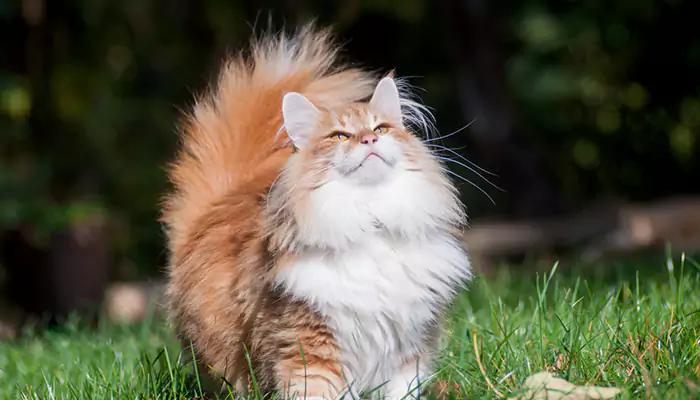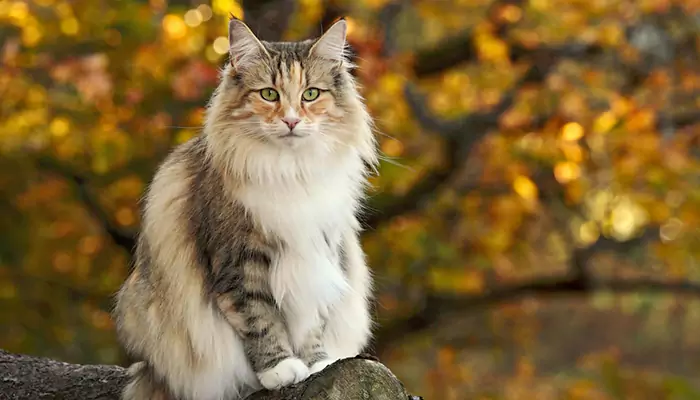
This large cat breed loves adventuring but loves to purr on its human’s lap too
Meet the Norwegian Forest Cat, or as they're lovingly called in Norway, the skogkatt, which translates to "forest cat." These enchanting creatures hail from the wilds of Norway, boasting a lineage that stretches back to Viking times. Imagine these majestic cats prowling the ancient Scandinavian forests alongside fierce Norse warriors!

Origin and Background
The Norwegian Forest Cat has a rich history intertwined with Norse mythology and the Vikings. As far back as the 16th century, images and descriptions resembling these majestic cats have been documented. They even starred in Norwegian folklore, where the Norse goddess Freya was said to have a chariot pulled by six enormous forest cats.
However, by the early 20th century, the breed faced extinction due to indiscriminate cross-breeding. Thankfully, their significance was recognized as a national treasure by Norway's King Olav V in 1938. This spurred efforts to preserve the breed through meticulous breeding programs, eventually saving them from the brink.
Appearance and Coat
With a luxurious double-layered coat, Norwegian Forest Cats are built to thrive in chilly climates. Their coat not only keeps them warm but also repels water, making them waterproof adventurers! Adorned with a distinctive ruff around the neck, tufted ears, and toes, these cats are naturally equipped to brave wintry weather. While tabby and white are common colors, Norwegian Forest Cats come in a variety of hues including white, black, blue, red, cream, silver, and golden. However, some shades like chocolate and lilac aren't recognized by breed standards. Their long, fluffy coat can sport solid, bicolour, tortoiseshell, calico, and tabby patterns.

Temperament
Norwegian Forest Cats are affectionate family pets, forming strong bonds with all family members. They are curious, easygoing, and playful by nature, though they prefer to dictate playtime on their terms. While they enjoy being part of family life, they're not fond of being lap cats due to their size. Males typically weigh between 5-7.5kg, while females range from 4-5.5kg. These cats are independent and territorial, preferring to make choices on their terms. However, they are known to make friends with visitors easily and are famous for their loud, contented purring.
Care Tips
Regular weekly grooming is essential to manage their dense coat and prevent tangles and matting. During shedding seasons, particularly in spring, brushing should be more frequent to manage the shedding of their undercoat. Their water-resistant coat requires occasional brushing to assist in managing fur and to strengthen the bond between cat and owner. Dental hygiene and nail trimming should be part of their routine care regimen. While they have a natural inclination for climbing, providing sturdy cat towers and shelves can satisfy their climbing instincts and keep their claws trimmed.
Norwegian Forest Cat is often confused for Maine Coon. Though they do look similar, there are differences in appearance, albeit subtle, between the two. It is often speculated that Maine Coons are descendants of Norwegian Forest cats. The difference is quite subtle.
One notable distinction lies in their head shapes. Norwegian Forest Cats typically sport a triangular face, while Maine Coons have a rounder visage.
When it comes to smarts, Maine Coons take the cake. They're known for their quick wit and ability to learn tricks, even mastering the art of walking on a lead and harness. Norwegian Forest Cats, on the other hand, might give you the cold shoulder when it comes to dog-like activities.
Maine Coons exhibit a more dog-like loyalty, shadowing their humans from room to room with unwavering devotion. Meanwhile, Norwegian Forest Cats maintain a more aloof demeanor, embodying a classic cat's approach to affection. Plus, Maine Coons retain their playful kittenish spirit well into adulthood, while Norwegian Forest Cats tend to be more laid-back.












